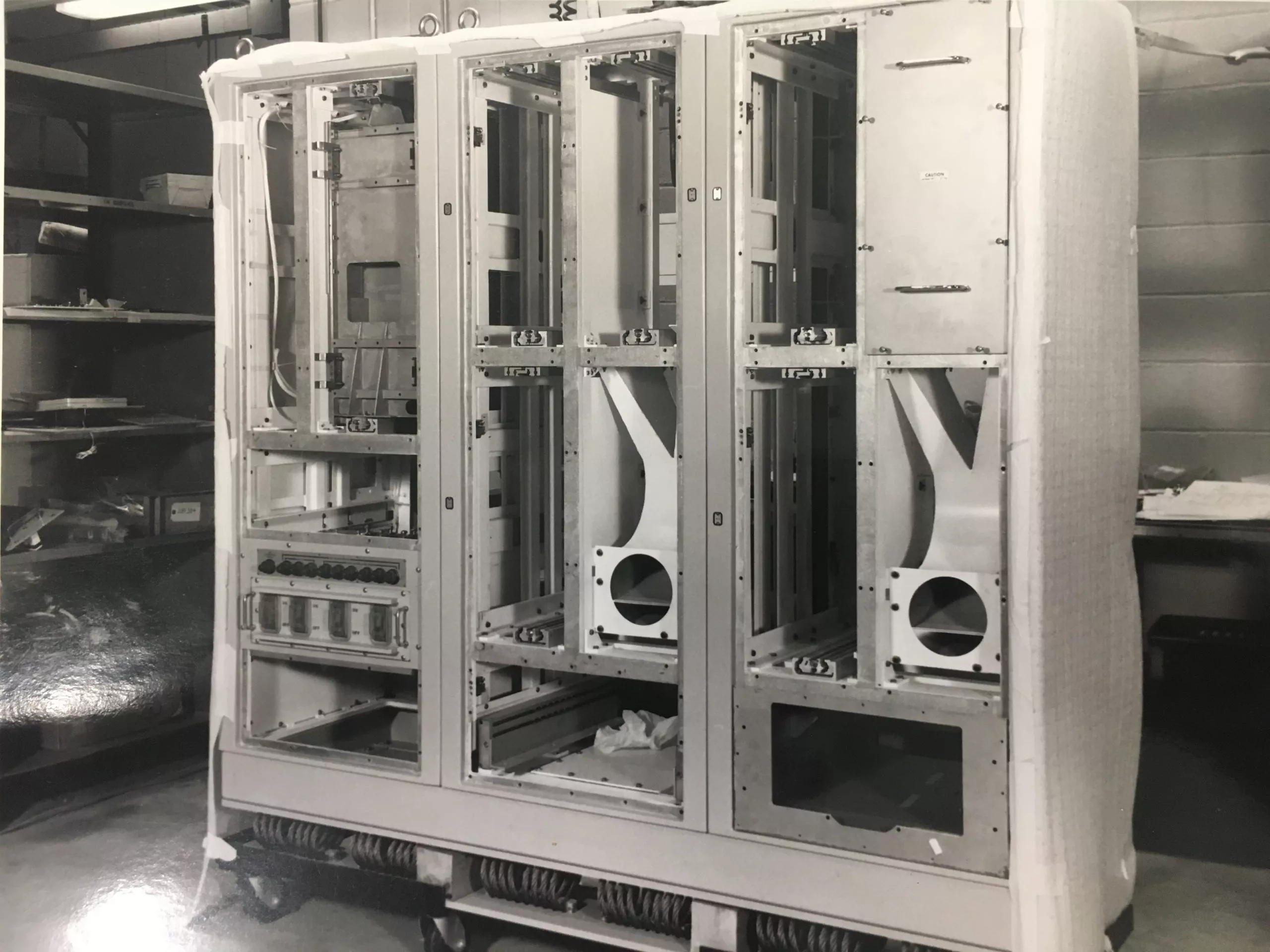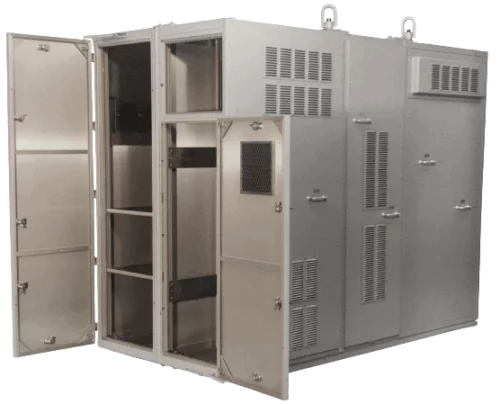Racks organize electronic equipment into standardized assemblies that not only help make efficient use of your space, but also safeguard each component, such as data servers, shipboard systems, and other critical electronic equipment, to ensure it operates reliably and protects it from external environmental damage.
The type of enclosure that you select for a project depends on where and how it will be used. Will it be used indoors or outdoors? Will it need to be waterproof? What type(s) of equipment will be installed?
While a rack design is rather basic, the equipment inside can store or process high volumes of information. The electronics found in racks typically support datacom or IT equipment such as network switches, servers, navigation systems, telecommunication routers, and other hardware. Industrial applications include test system components and large-scale battery storage.
The equipment layout can vary widely depending on how the electronics need to be housed or mounted. Racks can also accommodate accessories that support the equipment, such as cable management, PDUs, patch panels, thermal management systems, shelves, and drawers.
Continue reading below as we discuss rack enclosures in depth, covering the three main types of enclosures, various rack accessories, and the environmental factors the enclosures should be protected from. You’ll also learn the criteria required to select the correct rack enclosure based on your equipment’s weight, size, location, and other requirements.
What Is a Rack Enclosure?
Rack enclosures are an optimal solution for organizing electronics and IT equipment. They can free up space for efficient use of resources, and the sturdy aluminum construction can support up to 2,000 pounds of equipment.
The supporting framework of the rack secures two or four vertical rails for mounting purposes. The rails have square or round holes that make it easier to mount the equipment with screws. Rack enclosures are customizable to have front or rear doors, top panels, side panels, or bases as needed.
Common uses for electronic enclosures include but are not limited to the following:
- Scientific and testing equipment
- SATCOM or telecommunications equipment
- Utilities
- Networking or data centers
- Mission computing or electronic warfare systems
- Navigational guidance systems
A 19-inch rack is the standard enclosure or frame size for mounting electronic equipment, and it gets its name from the width of the front panel of the boxes installed in the rack enclosure. Other typical hole-to-hole spacing options are 23-inch (566.7 mm) and 24-inch (592.1 mm) racks. Cabinets typically enclose the rack and contain the required electrical connections, electromagnetic interference (EMI) shielding components, and cooling fans.
EIA STANDARDS
The Electronic Industries Alliance (EIA) is a group of trade associations for U.S. electronics manufacturers. The current standard is EIA-310-D. Since there is no governing body, compliance is not strictly enforced. Still, A&J Manufacturing adheres to EIA standards, following these specific guidelines for producing quality rack enclosure components:
The standard hole spacing on the mounting flange of a rack is spaced in groups of three holes. This group is a Rack Unit (U), with 1U equal to 1.75 inches (44.45 mm) of vertical space.
The vertical hole spacing has a repeating pattern of holes within 1U. The spacing of holes alternates at ½ in., ⅝ in., ⅝ in. and then repeats. The U space starts and stops in the middle of the 1/2-inch holes.
The standard horizontal hole spacing is 18 5/16 inches (465.1 mm), but it is not a universal dimension. Many manufacturers use equipment mounting slots to accommodate variations.
The rack opening has a minimum of 17 ¾ inches (450 mm).
The physical width of the electronic enclosure can vary, but the standard front panel width is 19 inches (482.6 mm).
Types of Rack Enclosures
Some of the most critical electronics in use today are for aerospace or defense personnel in harsh environments. Failure is not an option. There are three primary types of racks:
- Rack Cabinets
Rack enclosures for electronics are solid, freestanding cabinets with four adjustable vertical mounting rails, removable side panels, and front and rear doors. These rack enclosures provide adequate ventilation and can accommodate larger payloads, ideal for applications that require heavier equipment, hotter equipment, and higher wattages per rack.
Floor enclosures provide maximum security for the equipment and servers mounted inside them. However, they usually offer minimal space for cables.
- Open-Frame Racks
An open-frame rack is similar in structure to a rack cabinet unit but does not contain walls or doors. The rack enclosure may only have two vertical rails instead of the four rails commonly found in floor enclosures. This difference makes it difficult to mount servers or heavy equipment without using adapters.
Since there are no doors or walls, open-frame racks are not as secure as floor enclosures. However, they offer more room for cables and allow easy access for technicians.
- Workstation Consoles
Ruggedized workstation consoles are specifically designed to withstand the harsh and demanding conditions typical of military environments. They’re engineered to ensure reliability and integral for field operations, command centers and tactical environments, ensuring that personnel have reliable access to critical information and control systems.
How to Choose the Correct Rack Enclosure
Consider the following factors when choosing the correct rack enclosure:
- Material:
Aluminum is a common electronic enclosure material because of its corrosion resistance, durability, electric conductivity, and non-reactiveness to magnetic forces. A&J Manufacturing uses high-quality aluminum alloy extrusions to produce rack enclosures rated for varying levels of protection, from light-duty to heavy-duty applications. - Size:
Rack enclosures and cabinets are available in standard configurations and sizes, but they can be customized to accommodate non-standard equipment sizes. The ideal rack must have sufficient capacity for existing equipment with additional space available for expansion. It should offer easy access to the equipment for troubleshooting and maintenance and provide adequate ventilation to dissipate heat.- Height: Height is one of the most important considerations because it determines how many rack spaces are available for your equipment. Common heights for floor-standing racks are 42U, 45U, and 48U.
- Width: While the width of the rack’s mounting rails and the equipment itself are standardized, you also need to consider the external width of the rack. The standard width for a rack enclosure is 24 inches, but extra wide options are also available.
-
- Depth: The standard depth for a rack enclosure is around 42 inches, but you can get extra deep options to ensure there’s enough room for cabling, PDUs, and other accessories without blocking airflow. Mid-depth (36 inches) and shallow-depth (32 inches) are available, too.
- Payload (weight capacity):
An accurate estimate of the anticipated weight loading is essential and can vary based on the application. We offer light-duty racks that accommodate up to 500 pounds, medium-duty racks that can handle 1,200 pounds, and heavy-duty rugged electronic cabinet racks with an isolated payload of 1,600-2,000 pounds. Always place the heaviest equipment, such as UPS systems, toward the bottom of the rack to prevent it from becoming top-heavy and prone to tipping over. - Equipment Placement:
The location of equipment in the rack is vital to proper operation and to maximize space. It’s best to develop a detailed plan for equipment placement before you install it, including plans for future expansion. Other factors to consider include cable management for applications that require high-density cabling, or if you plan to install a rack console, you’ll need to consider human factors engineering for placement of the display and keyboard at a comfortable height.
Rack Accessories
After deciding what type and size of rack you need, there are some basic configuration options to consider. A&J Manufacturing offers a comprehensive selection of rack accessories, kits, and components to meet the demands of your specific application:
- Bayed Racks
- Blanking Panels
- Bus Bars
- Cable Management
- Doors
- EMI/RFI Shielding & Gasketing
- Fans
- Power Panels
- PDU
- RETMA Rails
- Shelves (Sliding and Fixed)
- Side Panels
- UPS
Environmental Protection
The key to understanding and selecting the most effective enclosure is to identify the variables in your environment and select an option that can withstand swings in climate or environmental conditions.
- Foreign Substances
These include water, dust, dirt, oil, and other airborne particles. Each can significantly damage the electronic equipment housed within the enclosure and increase the risk of breakdown or failure. - Temperature
Temperature can present challenges on two fronts—internal temperature affected by the heat generated from the operation of the devices and external or ambient temperature. - Corrosive Elements
These are outdoor factors such as sun, snow, salt, or chemicals.
For mission-critical military and defense applications, these protections are even more important. Our ruggedized aluminum electronic racks are designed to transport sensitive electronic equipment in these industries, protecting against impacts, shocks, vibrations, moisture, and electromagnetic interference. Our racks comply with stringent military specifications, including MIL-STD-167, MIL-STD-810, and MIL-S-901D.





